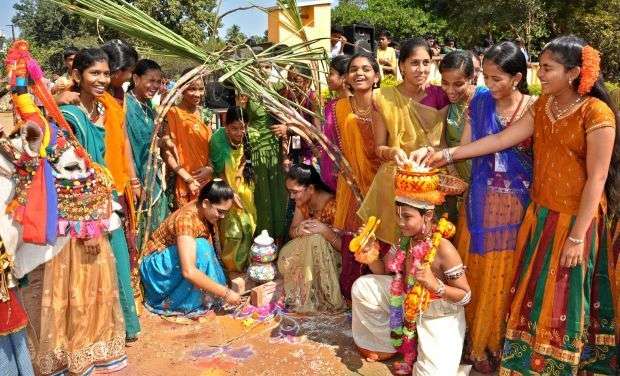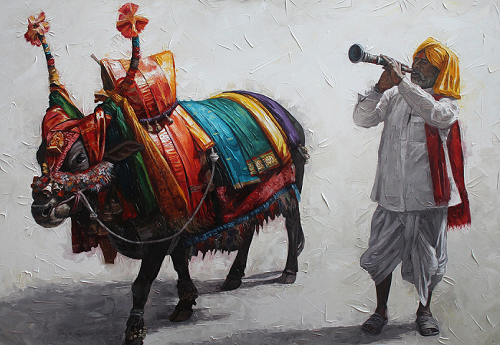Sankranti
The next day of Bhogi is Makara Sankranti. Uttarayana punyakala begins with Makara Sankranti. It is believed that people who die during this six months period will go directly to vaikuntam. This is the reason why Bhishma in Mahabharata who got voluntary death as a boon from his father waited unti this time to leave his body. People drop tila tarpan (dropping black sesame seeds with water) to their dead ancestors to liberate them from their sins they committed and to let them continue their journey to Vaikuntam.
Sankranti is a festival in reverence to the deity surya. So women wake up before dawn, clean their courtyard draw beautiful rangoli and fill rangoli with various colours. Then they decorate the entrance of their house with mari gold festoons and the thresholds by applying turmeric and vermilion paste. After taking bath and wearing new clothes they worship the sun god and offer payasam. This payasam is cooked in specially decorated earthen pots on the flame lit with cow dung cakes (which have been preserved for it) under the pavilion of sugar cane sticks in the presence of Sun god.
Sankranti is an harvest festival. So Godess Lakshmi will also be worshipped in the names of Dhanya Lakshmi or Sankranti Lakshmi to bless the farmers with good yieldings.
The new sons-in law are invited to their parents-in- law for Sankranti along with their better halves for a big feast. Garelu (made of black gram), Arisalu/attirasalu (made of rice flour and jaggery) along with other items are served in the meal on this day.
The big attraction of Sankranti is gangireddu. Gangireddu is a sacred bull which is considered as a form of Nandhiswara, a divine vehicle of Lord Siva. They are decorated with various clothes and with ringing bells around their neck and led by their master. The master goes house to house along with the bull and an accompanying person.
The master plays Nadaswaram and the accompanying person beats dolu. It symbolises the upcoming good luck of the householders.
The puranas says that on this day the Sun visits the house of his son Shani who is head of the Makararasi. This day symbolises the healthy relationship of father and son.








![[Live] – Tirumala Darshan Crowd Status Today Tirumala Darshan Crowd Status Today](https://tirupatitirumalainfo.com/wp-content/uploads/2019/01/live-tirumala-darshan-waiting-time-100x70.png)










